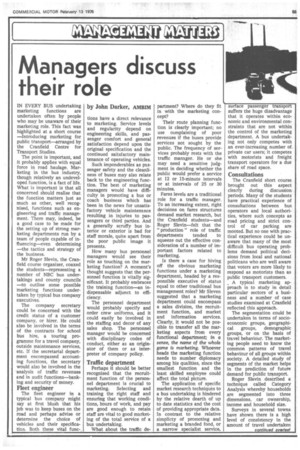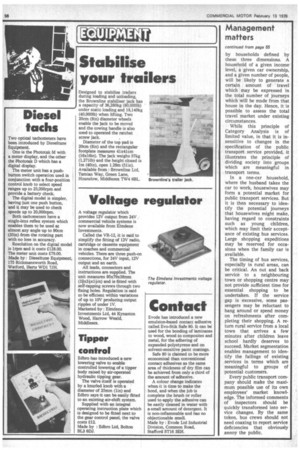Managers discuss their role
Page 57

Page 58

If you've noticed an error in this article please click here to report it so we can fix it.
by John Darker, AMBIM IN EVERY BUS undertaking marketing functions are undertaken often by people who may be unaware of their marketing role. This fact was highlighted at a short course —Introducing marketing for public transport—arranged by the Cranfield Centre for Transport Studies.
The point is important, and it probably applies with equal force in road haulage. Marketing in the bus industry, though relatively an undeveloped function, is a fact of life. What is important is that all concerned should realise that the function matters just as much as other, well recognised, functions such as engineering and traffic management. There may, indeed, be a good case to be made for the setting up of strong marketing departments run by a team of people capable of influencing—even determining —the tactics and strategy of the business.
Mr Roger Slevin, the Cranfield course organiser, coaxed the students—representing a number of NBC bus undertakings and county councils —to outline some possible marketing functions undertaken by typical bus company executives.
The company secretary could be concerned with the credit status of a customer company, or hirer. He could also be involved in the terms of the contracts for school bus hire, a touring programme for a travel company, outside maintenance services, etc. If the secretarial department encompassed accounting functions, the secretary would also be involved in the 'analysis of traffic revenues and in audit functions—banking and security of money.
Fleet engineer
The fleet engineer in a typical bus company might say at first blush that his job was to keep buses on the road and perhaps advise or determine the choice of vehicles and their specification. Both these vital func-. tions have a direct relevance to marketing. Service levels and regularity depend on engineering skills, and passenger comfort and general satisfaction depend upon the original specification and the continued saitsfactory maintenance of operating vehicles.
Such imponderables as passenger safety and the cleanliness of buses may also relate back to the engineering function. The best of marketing managers would have difficulty in promoting a bus or coach business which has been in the news for unsatisfactory vehicle maintenance resulting in injuries to passengers or third parties. And a generally scruffy bus interior or exterior is bad for staff morale, quite apart from the poor public image it presents.
How many bus personnel managers would see their role as touching on the marketing function? A moment's thought suggests that the personnel function is vitally significant. It probably embraces the training function—an indispensable adjunct to efficiency.
The personnel department would probably specify and order crew uniforms, and it could easily be involved in the staffing and decor of any sales shop. The personnel manager would be concerned with disciplinary codes of conduct, either as an originator of them or as interpreter of company policy.
Traffic department
Perhaps it should be better recognised that the recruitment function of the personnel department is crucial to marketing. Selecting and training the right staff and ensuring that working conditions, hours of work, and pay are good enough to retain staff are vital to good marketing of the total service of a bus undertaking.
What about the traffic de partment? Where do they fit in with the marketing concept?
Their route planning function is clearly important; no use complaining of poor revenues if the buses provide services not sought by the public. The frequency of services probably rests with the traffic manager. He or she may need a sensitive judgment in deciding whether the public would prefer a service at 12 or I5-minute intervals or at intervals of 25 or 30 minutes.
Fares levels are a traditional role for a traffic manager. To an increasing extent, right decisions on fares structures demand market research, but the Cranfield students—and Roger Slevin—felt that the " production" role of traffic departments tended to squeeze out the effective consideration of a number of important factors related to marketing.
Is there a case for hiving off the obvious marketing functions under a marketing department, headed by a responsible executive of status equal to other traditional bus management roles? Mr Sleven suggested that a marketing department could encompass a sales division, the recruitment function, and market and information services. Clearly, it would not be possible to transfer all the marketing aspects from every functional department; in a sense, the name of the whole game is marketing. Whoever heads the marketing function needs to number diplomacy among his qualities, since the smallest function and the least skilled employee could affect the total picture.
The application of specific market research techniques to a bus undertaking is hindered by the relative dearth of up to date statistics and the cost of providing appropriate data. In contrast to the relative simplicty of promoting and marketing a branded food, or a narrow specialist service, surface passenger transport suffers the huge disadvantage that it operates within economic and environmental constraints that are not within the control of the marketing department. A bus undertaking not only competes with an ever-increasing number of. private car users; it competes with motorists and freight transport operators for a due share of road space.
Consultations
The Cranfield short course brought out this aspect clearly during discussion periods. Many of the students have practical experience of consultations between bus operators and local authorities, where such concepts as road pricing and strict control of car parking are mooted. But no one with practical experience could be unaware that many of the most difficult bus operating problems demand political decisions from local and national politicans who are well aware that voters are more likely to respond as motorists than as public transport customers.
A typical marketing approach is to study in detail particular sectors of a business and a number of case studies examined at Cranfield reflected this approach.
The segmentation could be undertaken in terms of socioeconomic groups, geographical groups, demographic groups, or on the basis of travel behaviour. The marketing people need to know the common patterns of travel behaviour of all groups within society. A detailed study of segments of the market helps in the prediction of future demand for public transport.
Roger Slevin described a technique called Category Analysis whereby households are segmented into three dimensions, car ownership, income and household size.
Surveys in several towns have shown there is a high level of consistency in the amount of travel undertaken by households defined by these three dimensions. A household of a given income level, a given car ownership, and a given number of people, will be likely to generate a certain amount of travel which may be expressed in the total number of journeys which will be made from that house in the day. Hence, it is possible to assess the total travel market under existing circumstances.
While this principle of Category Analysis is of limited value, in that it is insensitive to changes in the specification of the public transport service provided, it illustrates the principle of dividing society into groups which are meaningful in transport terms.
In a one-car household, where the husband takes the car to work, housewives may form a potential market for public transport services. But it is then necessary to identify the potential journeys that housewives might make, having regard to constraints such as young children, which may limit their acceptance of existing bus services. Large shopping expeditions may be reserved for occasions when the family car is available.
The timing of bus services, especially in rural areas, can be critical. An out and back service to a neighbouring town or shopping centre may not provide sufficient time for essential shopping to be undertaken. If the service gap is excessive, some passengers may be reluctant to hang around or spend money on refreshments after completing their shopping. A return rural service from a local town that arrives a few minutes after children leave school hardly deserves to succeed. Market segmentation enables management to identify the failings of existing services in terms which are meaningful to groups of potential customers.
Every public transport company should make the maximum possible use of its own employees' market knowledge. The informed comments of inspectors should be quickly transformed into service changes. By the same token, bus crews should not need coaxing to report service deficiencies that obviously annoy the public.




























































































